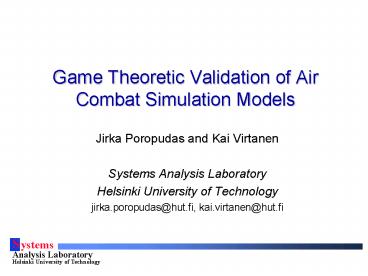Game Theoretic Validation of Air Combat Simulation Models - PowerPoint PPT Presentation
Title:
Game Theoretic Validation of Air Combat Simulation Models
Description:
Jirka Poropudas and Kai Virtanen Systems Analysis Laboratory Helsinki University of Technology jirka.poropudas_at_hut.fi, kai.virtanen_at_hut.fi – PowerPoint PPT presentation
Number of Views:71
Avg rating:3.0/5.0
Title: Game Theoretic Validation of Air Combat Simulation Models
1
Game Theoretic Validation of Air Combat
Simulation Models
- Jirka Poropudas and Kai Virtanen
- Systems Analysis Laboratory
- Helsinki University of Technology
- jirka.poropudas_at_hut.fi, kai.virtanen_at_hut.fi
2
Air combat simulation
- Air combat is analyzed to compare effectiveness
of tactics and ways for conducting missions as
well as system performance - Test flights are expensive and time consuming ?
constructive simulation - Discrete event simulation models provide a
controlled and reproducible environment that may
be complex and convoluted with many levels of
sub-models
- Air combat simulation model
- Aircraft, weapon systems, radars, other
apparatus - Pilot decision making and situation awareness
- Uncertainties
Validation of the model?
3
Existing validation and optimization approaches
- Simulation metamodels
- Mappings from simulation input to output
- - Response surface methods, regression models,
neural networks, etc. - Validation methods
- Real data, expert knowledge, statistical methods,
sensitivity analysis - Simulation-optimization methods
- Ranking and selection, stochastic gradient
approximation, metaheuristics, sample path
optimization
One-sided approaches ? Action of the adversary
is not taken into account
The game theoretic approach!
4
The game theoretic approach
- Definition of the scenario
- Aircraft, weapons, sensory and other systems
- Initial geometry
- Objectives ? Measures of effectiveness (MOEs)
- Available tactics and systems Tactical
alternatives - Simulation of the scenario using the simulation
model - Input tactical alternatives
- Output MOE estimates
- Estimation of games from the simulation data
using statistical techniques - Use of the games in validation
5
Games in validation
- Goal Confirming that the simulation model
performs as intended - Comparison of the scenario and properties of the
game - Symmetry
- Symmetric scenarios gt symmetric games
- Dependence between decision variables and payoffs
- Dependence between tactical alternatives and MOEs
- Best responses and Nash equilibria
- Explanation and interpretation based on the
scenario - Initiative
- Making ones decision before or after the
adversary gt Advantageous/disadvantageous? - Explanation and interpretation based on the
scenario
6
Validation example Aggression level
- Two-on-two air combat scenario
- Identical aircraft, air-to-air missiles, radars,
data links, etc. - Symmetric initial geometry
- Identical tactical alternatives
- - Aggression levels of pilots Low, Medium, High
- Objectives gt MOEs
- - Blue kills, red kills, difference of kills
- Simulation using X-Brawler
- Many versus many air combat simulation
- Discrete event simulation methodology
- Aircraft, weapons and other hardware models
- Elements describing pilot decision making and
situation awareness
7
Validation results
Payoff Blue kills
- Expert knowledge
- Increasing aggressiveness ?
- Increasing causality rates
- MOE blue kills
- Low aggressiveness for red
- High aggressiveness for blue
- Dependence
- Increasing aggressiveness
- gt Increase of blue kills
- Best responses Nash equilibria
- Medium or high for blue, low for red
- Medium and high leading to the same outcome gt
Possible shortcoming
8
Validation results
Payoff Blue kills Red kills
RED, min
- Expert knowledge
- Increasing aggressiveness
- gt Increasing causality rates
- Symmetric scenario
- gt Symmetric game
BLUE, max
- Symmetry
- MOE estimates approximately zero when the
decisions coincide - E.g., low, high gt best, worst AND high, low gt
worst, best - Dependence
- Increasing aggressiveness gt Increasing causality
rates for both sides - Medium and high for blue leading to the same
outcome gt Possible shortcoming - Best responses Nash equilibrium
- Low for blue, low for red
9
Conclusions
- Novel way to analyze air combat
- Combination of discrete event simulation and game
theory - Extension of one-sided validation and
optimization approaches - Validation
- Properties of games ? Air combat practices
- Simulation data in an informative form
- Comparison of tactical alternatives using games
- Systematic means for analyzing air combat
- - Single simulation batch
- Other application areas involving game settings

